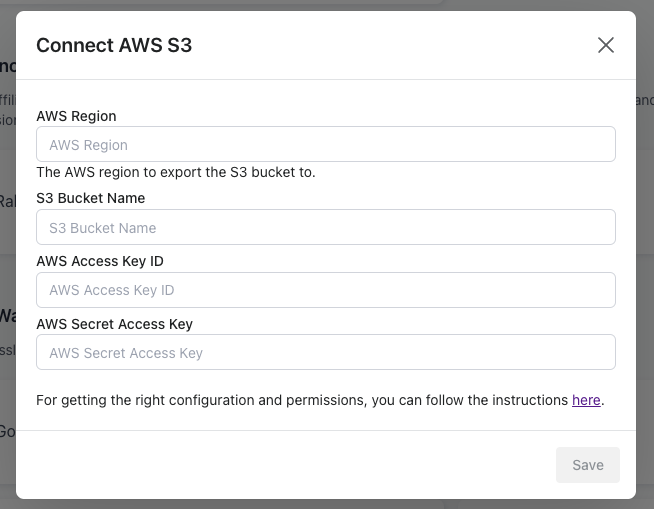Bucket and Permissions Setup
To sync data from Triple Whale to AWS S3, you must create an S3 bucket, configure an IAM user, and grant the necessary permissions. This guide walks you through the setup process to ensure a seamless connection.
Step 1: Create an S3 Bucket
- Open the AWS Console and navigate to S3.
- Click Create bucket.
- Enter a Bucket Name (e.g.,
triplewhale-data), and configure additional settings as needed. Learn more about creating S3 buckets. - Click Create bucket to finalize.
Step 2: Create an IAM User
- Open the AWS Console and navigate to IAM.
- In the left-hand menu, click Users.
- Click Create user.
- Enter a User name (e.g.,
triplewhale-s3-user). - Click Next to proceed.
Step 3: Create a Custom IAM Policy
-
On the Permissions page, click Attach policies directly and then Create policy.
-
Select the JSON tab and replace the content with the following, updating
<your-bucket-name>:{ "Version": "2012-10-17", "Statement": [ { "Sid": "VisualEditor0", "Effect": "Allow", "Action": ["s3:PutObject", "s3:GetObject", "s3:ListBucket"], "Resource": [ "arn:aws:s3:::<your-bucket-name>", "arn:aws:s3:::<your-bucket-name>/*" ] } ] } -
Click Next, enter a Policy name (e.g.,
TripleWhaleS3Policy), and click Create policy.
Step 4: Attach the Policy to the IAM User
- Return to the IAM User creation page.
- Click the Refresh button next to the policy list.
- Search for the newly created policy (e.g.,
TripleWhaleS3Policy) and select its checkbox. - Click Next and then Create user.
Step 5: Generate and Download Access Keys
- Go to IAM → Users.
- Click on the newly created user (e.g.,
triplewhale-s3-user). - Navigate to the Security credentials tab.
- Scroll to the Access keys section and click Create access key.
- Select Third-party service as the use case.
- Confirm and click Create.
- Click Download .csv file to save the credentials securely.
Step 6: Identify the AWS Region
- Look at the AWS Console URL (e.g.,
https://<region>.console.aws.amazon.com). - The
<region>in the URL indicates your AWS region (e.g.,us-east-1,eu-west-1).
Connecting to Triple Whale
Once you’ve set up your S3 bucket and IAM user, connect it to Triple Whale:
-
Go to your Triple Whale Integration page.
-
Click Connect on the AWS S3 integration.

Connecting AWS S3 to Triple Whale.
-
Enter the following details:
- Region: Found in Step 6.
- Bucket Name: Enter the bucket name created in Step 1 (e.g.,
triplewhale-data). - AWS Access Key ID: Found in the
.csvfile from Step 5. - AWS Secret Access Key: Found in the
.csvfile from Step 5.
-
Click Save.
Creating an Agent to Schedule Your Sync
After connecting your AWS S3 warehouse to Triple Whale, you can automate data exports by creating an Agent.
-
Open Agents
Go to Moby > Shop’s Agents in your Triple Whale account. Click New Agent or select an existing one to edit. -
Set AWS S3 Table as Your Destination
In the Agent builder, add a Send to Destinations step and pick Sync to Warehouse. Click Select Provider to choose your connected AWS S3 warehouse, and enter the Table ID where you wish to send your data (this should be a unique Table ID that doesn't already exist). -
Define Query
Check Use dedicated query, and provide your desired SQL query for the data export. (Note: For smaller exports, you may instead write a custom SQL query using a Get Data step in your agent, though we recommend the Use dedicated query for larger exports.)Select Specific ColumnsAvoid using
SELECT *in your queries. Our schema is dynamic, and using wildcard selection can lead to broken or inconsistent results as fields change. Always specify the exact columns you need. -
Configure Your Schedule
Choose how often you want the Agent to run (e.g., hourly). Once saved, Triple Whale will automatically send new rows to your AWS S3 dataset on that schedule.
Troubleshooting
Common Errors and Fixes
- "Access Denied": Ensure the IAM user has the correct permissions. Go to IAM > Policies and verify that the
TripleWhaleS3Policyis assigned.- "Bucket Not Found": Confirm that the correct bucket name was entered in the integration settings.
- "Invalid Credentials": Check that you are using the correct AWS Access Key ID and AWS Secret Access Key from the downloaded
.csvfile.